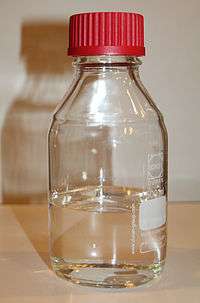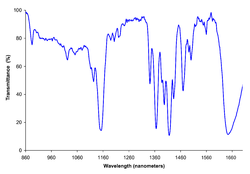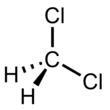Dichloromethane
Dichloromethane (DCM or methylene chloride) is an organochlorine compound with the formula CH2Cl2. This colorless, volatile liquid with a moderately sweet aroma is widely used as a solvent. Although it is not miscible with water, it is polar, and miscible with many organic solvents.[11]
| |||
 | |||
| Names | |||
|---|---|---|---|
| IUPAC name
Dichloromethane | |||
| Other names
Methylene chloride; Methylene dichloride; Solmethine; Narkotil; Solaesthin; Di-clo; Refrigerant-30; Freon-30; R-30; DCM; MDC | |||
| Identifiers | |||
CAS Number |
|||
3D model (JSmol) |
|||
| ChEBI | |||
| ChEMBL | |||
| ChemSpider | |||
| ECHA InfoCard | 100.000.763 | ||
| EC Number |
| ||
| KEGG | |||
PubChem CID |
|||
| RTECS number |
| ||
| UNII | |||
| UN number | 1593 | ||
CompTox Dashboard (EPA) |
|||
InChI
| |||
SMILES
| |||
| Properties | |||
Chemical formula |
CH2Cl2 | ||
| Molar mass | 84.93 g·mol−1 | ||
| Appearance | Colorless liquid | ||
| Odor | chloroform-like[1] | ||
| Density | 1.3266 g/cm3 (20 °C)[2] | ||
| Melting point | −96.7 °C (−142.1 °F; 176.5 K) | ||
| Boiling point | 39.6 °C (103.3 °F; 312.8 K) decomposes at 720 °C[3] 39.75 °C (103.55 °F; 312.90 K) at 760 mmHg[4] | ||
Solubility in water |
25.6 g/L (15 °C) 17.5 g/L (25 °C) 15.8 g/L (30 °C) 5.2 g/L (60 °C)[3] | ||
| Solubility | Miscible in ethyl acetate, alcohol, hexanes, benzene, CCl4, diethyl ether, CHCl3 | ||
| log P | 1.19[5] | ||
| Vapor pressure | 0.13 kPa (−70.5 °C) 2 kPa (−40 °C) 19.3 kPa (0 °C) 57.3 kPa (25 °C)[6] 79.99 kPa (35 °C)[3] | ||
Henry's law constant (kH) |
3.25 L·atm/mol[4] | ||
Magnetic susceptibility (χ) |
−46.6·10−6 cm3/mol | ||
Refractive index (nD) |
1.4244 (20 °C)[4][7] | ||
| Viscosity | 0.43 cP (20 °C)[4] 0.413 cP (25 °C) | ||
| Structure | |||
Dipole moment |
1.6 D | ||
| Thermochemistry | |||
Heat capacity (C) |
102.3 J/(mol·K)[6] | ||
Std molar entropy (S |
174.5 J/(mol·K)[6] | ||
Std enthalpy of formation (ΔfH⦵298) |
−124.3 kJ/mol[6] | ||
Std enthalpy of combustion (ΔcH⦵298) |
-454.0 kJ/mol (from standard enthalpies of formation)[6] | ||
| Hazards | |||
| Safety data sheet | See: data page | ||
| GHS pictograms |   | ||
| GHS Signal word | Warning | ||
GHS hazard statements |
H315, H319, H335, H336, H351, H373[7] | ||
GHS precautionary statements |
P261, P281, P305+351+338[7] | ||
| Eye hazard | Irritant | ||
| NFPA 704 (fire diamond) | |||
| Flash point | None, but can form flammable vapour-air mixtures above ≈100 °C [8] | ||
Autoignition temperature |
556 °C (1,033 °F; 829 K) | ||
| Explosive limits | 13%-23%[1] | ||
| Lethal dose or concentration (LD, LC): | |||
LD50 (median dose) |
1.25 g/kg (rats, oral) 2 g/kg (rabbits, oral)[3] | ||
LC50 (median concentration) |
24,929 ppm (rat, 30 min) 14,400 ppm (mouse, 7 h)[9] | ||
LCLo (lowest published) |
5000 ppm (guinea pig, 2 h) 10,000 ppm (rabbit, 7 h) 12,295 ppm (cat, 4.5 h) 14,108 ppm (dog, 7 h)[9] | ||
| NIOSH (US health exposure limits): | |||
PEL (Permissible) |
25 ppm over 8 hours (time-weighted average), 125 ppm over 15 minutes (STEL)[1][10] | ||
REL (Recommended) |
Ca[1] | ||
IDLH (Immediate danger) |
Ca [2300 ppm][1] | ||
| Supplementary data page | |||
Structure and properties |
Refractive index (n), Dielectric constant (εr), etc. | ||
Thermodynamic data |
Phase behaviour solid–liquid–gas | ||
Spectral data |
UV, IR, NMR, MS | ||
Except where otherwise noted, data are given for materials in their standard state (at 25 °C [77 °F], 100 kPa). | |||
| Infobox references | |||
Occurrence
Natural sources of dichloromethane include oceanic sources, macroalgae, wetlands, and volcanoes.[12] However, the majority of dichloromethane in the environment is the result of industrial emissions.[12]
Production
DCM is produced by treating either chloromethane or methane with chlorine gas at 400–500 °C. At these temperatures, both methane and chloromethane undergo a series of reactions producing progressively more chlorinated products. In this way, an estimated 400,000 tons were produced in the US, Europe, and Japan in 1993.[11]
- CH4 + Cl2 → CH3Cl + HCl
- CH3Cl + Cl2 → CH2Cl2 + HCl
- CH2Cl2 + Cl2 → CHCl3 + HCl
- CHCl3 + Cl2 → CCl4 + HCl
The output of these processes is a mixture of chloromethane, dichloromethane, chloroform, and carbon tetrachloride as well as hydrogen chloride as a byproduct. These compounds are separated by distillation.
DCM was first prepared in 1839 by the French chemist Henri Victor Regnault (1810–1878), who isolated it from a mixture of chloromethane and chlorine that had been exposed to sunlight.[13]
Uses
DCM's volatility and ability to dissolve a wide range of organic compounds makes it a useful solvent for many chemical processes.[11]
It is widely used as a paint stripper and a degreaser.[14] In the food industry, it has been used to decaffeinate coffee and tea as well as to prepare extracts of hops and other flavorings.[15] Its volatility has led to its use as an aerosol spray propellant and as a blowing agent for polyurethane foams.
Specialized uses

The chemical compound's low boiling point allows the chemical to function in a heat engine that can extract mechanical energy from small temperature differences. An example of a DCM heat engine is the drinking bird. The toy works at room temperature.[16] It is also used as the fluid in Christmas lights that have the colored bubbling tube above a lamp as a source of heat and a small amount of rock salt to provide thermal mass and a nucleation site for the phase changing solvent.
DCM chemically welds certain plastics. For example, it is used to seal the casing of electric meters. Often sold as a main component of plastic welding adhesives, it is also used extensively by model building hobbyists for joining plastic components together. It is commonly referred to as "Di-clo."
It is used in the garment printing industry for removal of heat-sealed garment transfers, and its volatility is exploited in novelty items: bubble lights and jukebox displays.
DCM is used in the material testing field of civil engineering; specifically it is used during the testing of bituminous materials as a solvent to separate the binder from the aggregate of an asphalt or macadam to allow the testing of the materials.[17]
Dichloromethane extract of Asparagopsis taxiformis, a seaweed fodder for cattle, has been found to reduce their methane emissions by 79%.[18]
Toxicity
DCM is the least toxic of the simple chlorohydrocarbons, but it is not without health risks, as its high volatility makes it an acute inhalation hazard.[19][20] It can also be absorbed through the skin.[1][14]
Symptoms of acute overexposure to dichloromethane via inhalation include difficulty concentrating, dizziness, fatigue, nausea, headaches, numbness, weakness, and irritation of the upper respiratory tract and eyes. More severe consequences can include suffocation, loss of consciousness, coma, and death.[1][14]
DCM is also metabolized by the body to carbon monoxide potentially leading to carbon monoxide poisoning.[21] Acute exposure by inhalation has resulted in optic neuropathy[22] and hepatitis.[23] Prolonged skin contact can result in DCM dissolving some of the fatty tissues in skin, resulting in skin irritation or chemical burns.[24]
It may be carcinogenic, as it has been linked to cancer of the lungs, liver, and pancreas in laboratory animals.[25] Other animal studies showed breast cancer and salivary gland cancer. Research is not yet clear as to what levels may be carcinogenic.[1][14] DCM crosses the placenta. Fetal toxicity in women who are exposed to it during pregnancy, however, has not been proven.[26] In animal experiments, it was fetotoxic at doses that were maternally toxic but no teratogenic effects were seen.[25]
In people with pre-existing heart problems, exposure to DCM can cause abnormal heart rhythms and/or heart attacks, sometimes without any other symptoms of overexposure.[14] People with existing liver, nervous system, or skin problems may worsen after exposure to methylene chloride.[10]
Regulation
In many countries, products containing DCM must carry labels warning of its health risks.
In February 2013, the U.S. Occupational Safety and Health Administration (OSHA) and the National Institute for Occupational Safety and Health warned that at least 14 bathtub refinishers have died since 2000 from DCM exposure. These workers had been working alone, in poorly ventilated bathrooms, with inadequate or no respiratory protection, and no training about the hazards of DCM.[10][14][27] OSHA has since then issued a DCM standard.[28] In the European Union, the European Parliament voted in 2009 to ban the use of DCM in paint-strippers for consumers and many professionals.[29] The ban took effect in December 2010.[30]
In Europe, the Scientific Committee on Occupational Exposure Limit Values (SCOEL) recommends for DCM an occupational exposure limit (8 h time-weighted average) of 100 ppm and a short-term exposure limit (15 min) of 200 ppm.[31]
Concerns about its health effects have led to a search for alternatives in many of these applications.[11][32]
On March 15, 2019, the U.S. Environmental Protection Agency (EPA) issued a final rule to prohibit the manufacture (including import), processing, and distribution of methylene chloride in all paint removers for consumer use, effective in 180 days.
Environmental effects
Ozone
Dichloromethane is not classified as an ozone-depleting substance by the Montreal Protocol.[33] The U.S. Clean Air Act does not regulate dichloromethane as an ozone depleter.[34] According to the EPA, the atmospheric lifetime of dichloromethane is very short, such that the substance decomposes before reaching the ozone layer.
Ozone concentrations measured at the midlatitudes from the ground up through the stratosphere from 1998 to 2016 have declined by 2.2 Dobson units.[35] The reasons for this decline are unclear, but one unverified hypothesis is the presence of short-lived substances such as dichloromethane in the lower atmosphere.[36]
See also
- Carbon tetrachloride
- List of chemical compounds
- List of organic compounds
- Trichloromethane (chloroform)
- Carbon monoxide-releasing molecules
References
- NIOSH Pocket Guide to Chemical Hazards. "#0414". National Institute for Occupational Safety and Health (NIOSH).
- Haynes, William M., ed. (2011). CRC Handbook of Chemistry and Physics (92nd ed.). Boca Raton, FL: CRC Press. p. 3.164. ISBN 1439855110.
- Properties of Dichloromethane. chemister.ru
- CID 6344 from PubChem
- "Dichloromethane_msds".
- Methylene chloride in Linstrom, Peter J.; Mallard, William G. (eds.); NIST Chemistry WebBook, NIST Standard Reference Database Number 69, National Institute of Standards and Technology, Gaithersburg (MD), http://webbook.nist.gov (retrieved 2014-05-26)
- Sigma-Aldrich Co., Dichloromethane. Retrieved on 2014-05-26.
- "Real time measurement of dichloromethane containing mixtures" (PDF). Health & Safety Laboratory. Retrieved 5 August 2015.
- "methylene chloride". Immediately Dangerous to Life and Health Concentrations (IDLH). National Institute for Occupational Safety and Health (NIOSH).
- "Methylene Chloride Hazards for Bathtub Refinishers". OSHA-NIOSH Hazard Alert 2013-110. OSHA and NIOSH. Retrieved 22 January 2015.
- Rossberg, M. et al. (2006) "Chlorinated Hydrocarbons" in Ullmann's Encyclopedia of Industrial Chemistry, Wiley-VCH, Weinheim. doi:10.1002/14356007.a06_233.pub2.
- Gribble, Gordon W. (2009). Naturally Occurring Organohalogen Compounds. Springer. ISBN 978-3211993248.
- Regnault, V. (1839) "De l'action du chlore sur les éthers hydrochloriques de l'alcool et de l'esprit de bois, et de plusieurs points de la théorie des éthers" (On the action of chlorine on the hydrochloric ethers of ethanol and methanol, and on several points of the theory of ethers), Annales de chimie et physique, series 2, 71 : 353–431; see especially: "Seconde partie. De l'action du chlore sur l'éther hydrochlorique de l'esprit de bois" (Second part. On the action of chlorine on the hydrochloric ether of methanol [i.e., chloromethane]), pages 377–380. Regnault gives dichloromethane the name éther hydrochlorique monochloruré (monochlorinated hydrochloric ether). Note: Regnault gives the empirical formula for dichloromethane as C2H4Cl4 because during that era, chemists used incorrect atomic masses.
Reprinted in German in:- Regnault, V. (1840). "Ueber die Einwirkung des Chlors auf die Chlorwasserstoffäther des Alkohols und Holzgeistes und über mehrere Punkte der Aethertheorie". Annalen der Chemie und Pharmacie. 33 (3): 310–334. doi:10.1002/jlac.18400330306. See p. 328.
- Regnault, V. (1840). "Ueber die Wirkung des Chlors auf den Chlorwasserstoffäther des Alkohols und des Holzgeistes, so wie über mehrere Puncte der Aethertheorie". Journal für Praktische Chemie. 19: 193–218. doi:10.1002/prac.18400190134. See p. 210.
- Hall, Ronald M. (4 February 2013). "Dangers of Bathtub Refinishing". National Institute for Occupational Safety and Health. Retrieved 21 January 2015.
- Office of Environmental Health Hazard Assessment (September 2000). "Dichloromethane" (PDF). Public Health Goals for Chemicals in Drinking Water. California Environmental Protection Agency. Retrieved June 5, 2016.
- Perelman, Yakov (1972) [1936]. Physics for Entertainment. 2. pp. 175–178. ISBN 978-1401309213.
- Shell Bitumen (2003-09-25). The Shell Bitumen Handbook. ISBN 978-0-7277-3220-0.
- Lorenna Machado, Marie Magnusson, Nicholas Paul, Nigel Tomkins (2016). "Identification of bioactives from the red seaweed Asparagopsis taxiformis that promote antimethanogenic activity in vitro". Journal of Applied Phycology. 28. doi:10.1007/s10811-016-0830-7.CS1 maint: multiple names: authors list (link)
- Rioux JP, Myers RA (1988). "Methylene chloride poisoning: a paradigmatic review". J Emerg Med. 6 (3): 227–238. doi:10.1016/0736-4679(88)90330-7. PMID 3049777.
- CDC (2012). "Fatal Exposure to Methylene Chloride Among Bathtub Refinishers — United States, 2000–2011". MMWR. 61 (7): 119–122.
- Fagin J, Bradley J, Williams D (1980). "Carbon monoxide poisoning secondary to inhaling methylene chloride". Br Med J. 281 (6253): 1461. doi:10.1136/bmj.281.6253.1461. PMC 1714874. PMID 7437838.
- Kobayashi A, Ando A, Tagami N, Kitagawa M, Kawai E, Akioka M, Arai E, Nakatani T, Nakano S, Matsui Y, Matsumura M (2008). "Severe optic neuropathy caused by dichloromethane inhalation". J Ocul Pharmacol and Ther. 24 (6): 607–612. doi:10.1089/jop.2007.0100. PMID 19049266.
- Cordes DH, Brown WD, Quinn KM (1988). "Chemically induced hepatitis after inhaling organic solvents". West J Med. 148 (4): 458–460. PMC 1026148. PMID 3388849.
- Wells GG, Waldron HA (1984). "Methylene chloride burns". Br J Ind Med. 41 (3): 420. doi:10.1136/oem.41.3.420. PMC 1009322. PMID 6743591.
- USDHHS. "Toxicological Profile for Methylene Chloride" (PDF). Retrieved 2006-09-10.
- Bell BP, Franks P, Hildreth N, Melius J (1991). "Methylene chloride exposure and birthweight in Monroe County, New York". Environ Res. 55 (1): 31–9. doi:10.1016/S0013-9351(05)80138-0. PMID 1855488.
- OSHA QuickTakes, February 1, 2013;
- Methylene Chloride. Occupational Safety & Health Administration. osha.gov
- "EU Banning Most DCM Paint Strippers," PaintSquare News, retrieved 1/5/14.
- "COMMISSION REGULATION (EU) No 276/2010 (Official Journal of the European Union, L 86/7)". 2010-04-01. Retrieved 2012-02-07.
- "SCOEL recommendations". 2011-04-22. Retrieved 2011-04-22.
- "Summary of Regulations Controlling Air Emissions from Paint Stripping and Miscellaneous Surface Coating Operations" (PDF). U.S. Environmental Protection Agency – NESHAP 6H. Cite journal requires
|journal=(help) - United States Environmental Protection Agency. "Ozone-Depleting Substances". Retrieved April 20, 2018.
- United States Environmental Protection Agency (October 1995). "Questions and Answers on Ozone-Depleting Solvents and Their Substitutes". Retrieved April 20, 2018.
- Reese, April (2018-02-09). "As polar ozone mends, UV shield closer to equator thins". Science. 359 (6376): 623. doi:10.1126/science.359.6376.623. ISSN 0036-8075. PMID 29439223.
- Ball, W. T.; Alsing, J.; Mortlock, D. J.; Staehelin, J.; Haigh, J. D.; Peter, T.; Tummon, F.; Stübi, R.; Stenke, A. (2018-02-06). "Evidence for a continuous decline in lower stratospheric ozone offsetting ozone layer recovery" (PDF). Atmos. Chem. Phys. 18 (2): 1379–1394. doi:10.5194/acp-18-1379-2018. ISSN 1680-7324.
External links
| Wikimedia Commons has media related to Dichloromethane. |
- International Chemical Safety Card 0058
- NIOSH Pocket Guide to Chemical Hazards. "#0414". National Institute for Occupational Safety and Health (NIOSH).
- National Pollutant Inventory – Dichloromethane Fact Sheet
- Dichloromethane at National Toxicology Program
- IARC Summaries & Evaluations Vol. 71 (1999)
- Canadian Environmental Protection Act Priority Substances List Assessment Report
- Organic Compounds Database
- Sustainable uses and Industry recommendations


